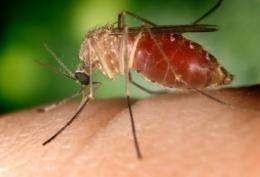West Nile virus more prevalent in low-income neighborhoods, study finds

Low-income neighborhoods appear to be the most susceptible to West Nile virus, a mosquito-transmitted disease that is linked to more than 1,000 deaths since in the United States since 1999, according to new UCLA-lead research.
Using data on infected humans and mosquitoes from the West Nile virus hotspot of Orange County, Calif., from 2005-08, scientists found that per-capita income and other economic conditions were the single greatest predictor of occurrence, explaining 85-95 percent of the variation. While economic conditions have previously been linked to disease, the study is the first to use a rigorous statistical model.
“We are seeing more West Nile virus not only in humans in these lower-income areas but in the mosquito populations as well, so the finding can’t just be attributable to differences in human behavior,” said Ryan Harrigan, a post-doctoral scholar with the Center for Tropical Research at the UCLA Institute of the Environment and Sustainability, and the study’s lead author. “Clearly, there are other factors.”
Among the potential factors influencing the prevalence of the virus in lower-income areas, researchers said, are abandoned swimming pools in areas with foreclosed homes and antiquated water runoff systems that provide favorable breeding habitat for mosquitoes. Another factor may be lower levels of political participation among residents, they said.
The research, funded by the U.S. Environmental Protection Agency, was published in the peer-reviewed scientific journal PLoS One. It was overseen by Professor Thomas Smith of the UCLA Department of Ecology and Evolutionary Biology and director of the Center for Tropical Research.
West Nile virus was first detected in North America in 1999. Mosquitoes catch it by biting infected birds, then spread it to humans. It has been linked to more than a thousand human deaths as well as significant declines in bird populations, according to the Centers for Disease Control and Prevention.
Approximately 80 percent of people infected show no symptoms, and one in five show relatively mild symptoms such as fever, headache, nausea and vomiting, the CDC says. The most serious cases occur in only about one of every 150 people infected and include symptoms that may include high fever, neck stiffness, disorientation, coma, convulsions, muscle weakness, vision loss, numbness and paralysis.
The findings hold potentially broad impacts, given the economic downturn and the potentially devastating effect of West Nile virus and other emerging infectious diseases on urbanized environments, the EPA said. The results underscore the importance of investigating economic factors in disease transmission and how such knowledge may help reduce and prevent disease.
In addition to Smith, co-authors were Henri Thomassen, a post-doctoral at the Center for Tropical Research; Wolfgang Buermann, an adjunct assistant professor at the UCLA Institute of the Environment and Sustainability and the Department of Atmospheric and Oceanic Sciences, and Robert Cummings, a biologist with the Orange County Vector Control District. Also contributing was Matthew Kahn, a professor at the UCLA Institute of the Environment and Sustainability with joint appointments in economics and public policy.














